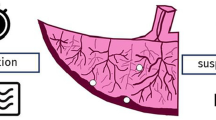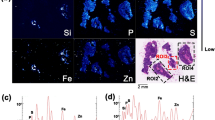Abstract
The placenta is the organ that mediates transport of nutrients and waste materials between mother and fetus. Synchrotron X-ray fluorescence (SXRF) microanalysis is a tool for imaging the distribution and quantity of elements in biological tissue, which can be used to study metal transport across biological membranes. Our aims were to pilot placental biopsy specimen preparation techniques that could be integrated into an ongoing epidemiology birth cohort study without harming rates of sample acquisition. We studied the effects of fixative (formalin or glutaraldehyde) and storage duration (30 days or immediate processing) on metal distribution and abundance and investigated a thaw-fixation protocol for archived specimens stored at −80 °C. We measured fixative elemental composition with and without a placental biopsy via inductively coupled plasma mass spectrometry (ICP-MS) to quantify fixative-induced elemental changes. Formalin-fixed specimens showed hemolysis of erythrocytes. The glutaraldehyde-paraformaldehyde solution in HEPES buffer (GTA-HEPES) had superior anatomical preservation, avoided hemolysis, and minimized elemental loss, although some cross-linking of exogenous Zn was evident. Elemental loss from tissue stored in fixative for 1 month showed variable losses (≈40 % with GTA-HEPES), suggesting storage duration be controlled for. Thawing of tissue held at −80 °C in a GTA-HEPES solution provided high-quality visual images and elemental images.




Similar content being viewed by others
References
Barker D (1998) Babies and health in later life. Churchhill Livingstone, Edinburgh
Fernandez-Twinn DS, Ozanne SE (2006) Mechanisms by which poor early growth programs type-2 diabetes, obesity and the metabolic syndrome. Physiol Behav 88(3):234–243
Jones HN, Powell TL, Jansson T (2007) Regulation of placental nutrient transport—a review. Placenta 28(8–9):763–774
Couzin-Frankel J (2013) Mysteries of development. How does fetal environment influence later health? Science 340(6137):1160–1161
Lanzirotti A, Sutton S. Hard X-ray microprobe. Brookhaven National Laboratory–National Synchrotron Light Source; 2002 [updated May 2002; cited 2002 July]. 1:[Available from: http://nslsweb.nsls.bnl.gov/nsls/pubs/nslspubs/imaging0502/introduction.pdf
Punshon T, Ricachenevsky FK, Hindt MF, Socha A, Zuber H (2013) Methodological approaches for using synchrotron X-ray fluorescence (SXRF) imaging as a tool in ionomic characterization: examples from whole plant imaging of Arabdiopsis thaliana. Metallomics 5(9):1133–1145
Kim SA, Punshon T, Lanzirotti A, Liangtao L, Alonso JM, Ecker JR et al (2006) Localization of iron in Arabidopsis seed requires the vacuolar membrane transporter VIT1. Science 314(5803):1295–1298
Karagas MR, Tosteson TD, Blum J, Morris JS, Baron JA, Klaue B (1998) Design of an epidemiologic study of drinking water arsenic exposure and skin and bladder cancer risk in a US population. Environ Health Perspect 106:1047–1050
Punshon T, Davis MA, Marsit CJ, Theiler SK, Baker ER, Jackson BP et al (2015) Placenta arsenic concentration in relation to both maternal and infant biomarkers of exposure in a US cohort. J Expo Sci Environ Epidemiol. doi:10.1038/jes.2015.16
Flanagan SM, Belaval M, Ayotte JD (2014) Arsenic, iron, lead, manganese and uranium concentrations in private bedrock wells in Southeastern New Hampshire, 2012–2013. USGS Fact Sheet 2014–3042
Roels HA, Bowler RM, Kim Y, Claus Henn B, Mergler D, Hoet P et al (2012) Manganese exposure and cognitive deficits: a growing concern for manganese neurotoxicity. Neurotoxicology 33(4):872–880
Al-Saleh I, Shinwari N, Nester N, Mashhour A, Moncari L, El Din Mohamed G et al (2008) Longitudinal study of prenatal and postnatal lead exposure and early cognitive development in Al-Khark, Saudi Arabia: a preliminary results of cord blood lead levels. J Trop Pediatr 54(5):300–307
Fei DL, Koestler DC, Li Z, Giambelli C, Sanchez-Mejias A, Gosse JA et al (2013) Association between in utero arsenic exposure, placental gene expression, and infant birth weight: a US birth cohort study. Environ Health 12:58
Hackett MJ, McQuillan JA, El-Assaad F, Aitken JB, Levina A, Cohen DD et al (2011) Chemical alterations to murine brain tissue induced by formalin fixation: implications for biospectroscopic imaging and mapping studies of disease pathogenesis. Analyst 136(14):2941–2952
Gellein K, Flaten TP, Erikson KM, Aschner M, Syversen T (2008) Leaching of trace elements from biological tissue by formalin fixation. Biol Trace Elem Res 121(3):221–225
Chwiej J, Szczerbowska-Boruchowska M, Lankosz M, Wojcik S, Falkenberg G, Stegowski Z et al (2005) Preparation of tissue samples for X-ray fluorescence microscopy. Spectrochim Acta B 60(12):1531–1537
Al-Ebraheem A, Dao E, Desouza E, Li C, Wainman BC, McNeill FE et al (2015) Effect of sample preparation techniques on the concentrations and distributions of elements in biological tissues using microSRXRF: a comparative study. Physiol Meas 36(3):N51–N60
Punshon T, Hirschi KD, Lanzirotti A, Lai B, Guerinot ML (2012) The role of CAX1 and CAX3 in elemental distribution and abundance in Arabidopsis seed. Plant Physiol 158(1):352–362
Alberts B, Johnson A, Lewis J, Raff M, Roberts K, Walter P (2002) Molecular biology of the cell, 4th edn. Taylor & Francis, New York
Chen S, Deng J, Yuan Y, Flachenecker C, Mak R, Hornberger B et al (2014) The Bionanoprobe: hard X-ray fluorescence nanoprobe with cryogenic capabilities. J Synchrotron Radiat 21(Pt 1):66–75
Vogt S (2003) MAPS: a set of software tools for analysis and vizualization of 3D x-ray fluorescence data sets. J Phys IV 104:635–638
Bastin J, Drakesmith H, Rees M, Sargent I, Townsend A (2006) Localisation of proteins of iron metabolism in the human placenta and liver. Br J Haematol 134(5):532–543
Brown PJ, Johnson PM, Ogbimi AO, Tappin JA (1979) Characterization and localization of human placental ferritin. Biochem J 182(3):763–769
Medalia O, Weber I, Frangakis AS, Nicastro D, Gerisch G, Baumeister W (2002) Macromolecular architecture in eukaryotic cells visualized by cryoelectron tomography. Science 298(5596):1209–1213
Forster F, Medalia O, Zauberman N, Baumeister W, Fass D (2005) Retrovirus envelope protein complex structure in situ studied by cryo-electron tomography. Proc Natl Acad Sci U S A 102(13):4729–4734
Studer D, Graber W, Al-Amoudi A, Eggli P (2001) A new approach for cryofixation by high-pressure freezing. J Microsc 203(Pt 3):285–294
Matsuyama S, Shimura M, Fuji M, Maeshima M, Yumoto H, Mimura H et al (2010) Elemental mapping of frozen-hydrated cells with cryo-scanning X-ray fluorescence microscopy. X-Ray Spectrom 39:260–266
Schrag M, Dickson A, Jiffry A, Kirsch D, Vinters HV, Kirsch W (2010) The effect of formalin fixation on the levels of brain transition metals in archived samples. Biometals Int J Role Met Ions Biol Biochem Med 23(6):1123–1127
James SA, Myers DE, de Jonge MD, Vogt S, Ryan CG, Sexton BA et al (2011) Quantitative comparison of preparation methodologies for X-ray fluorescence microscopy of brain tissue. Anal Bioanal Chem 401(3):853–864
Acknowledgments
This work was supported in part by the following: P20 GM104416 from the National Institute of General Medical Sciences, P01ES022832 and P42 ES007373 from the National Institute of Environmental Health at the NIH, and RD83544201 from the Environmental Protection Agency. This research used resources of the Advanced Photon Source, a US Department of Energy (DOE) Office of Science User Facility operated by the DOE Office of Science by Argonne National Laboratory under Contract No. DE-AC02-06CH11357.
Author information
Authors and Affiliations
Corresponding author
Electronic supplementary material
Below is the link to the electronic supplementary material.
ESM 1
(PDF 1918 kb)
Rights and permissions
About this article
Cite this article
Punshon, T., Chen, S., Finney, L. et al. High-resolution elemental mapping of human placental chorionic villi using synchrotron X-ray fluorescence spectroscopy. Anal Bioanal Chem 407, 6839–6850 (2015). https://doi.org/10.1007/s00216-015-8861-5
Received:
Revised:
Accepted:
Published:
Issue Date:
DOI: https://doi.org/10.1007/s00216-015-8861-5




